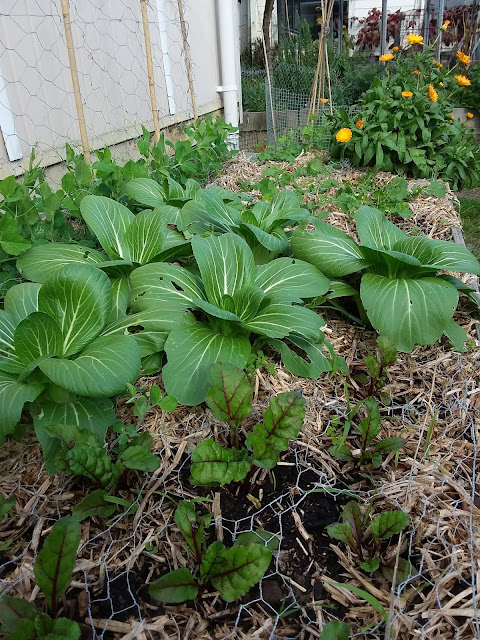Winter in the Garden
Yesterday was the first day of Winter here in New Zealand, as it is counted as the first of the month. We are of course still three weeks off from the shortest day. I continue to keep an eye on the habits of the sun; I have found a sunny little corner of my back deck to tuck the pot of carrot seedlings into. I have plans to pot up the Florence fennel next to it. My sunny spot on top of the garden chest where seedlings and stray potted plants used to do so well is now in shadow most of the day.
Here are the carrot seedlings in their new location, making slow but steady progress in this cold weather:
The peas are really starting to shine, taking well to the sunny spots in both the pot and the main veggie bed. They are a cheerful sight right now, growing strong and starting to produce pods:
I've done pretty well this year with Fall planting compared to what I have managed in the past. This is partly thanks to the lockdown; I needed this outlet of gardening more so than ever before. Still, there are some Fall tasks that I have left too late and now must see what I can do about them at the beginning of Winter.
We got our first frost last week, and that was the beginning of the end for the kumera. I have seen cold weather kill back veggies, but the effect on the kumera veggitation was kind of dramatic. That very afternoon, after the sun had melted off all the frost, some of the kumera leaves were black and disentigrated. Here they are, a day later, looking dry and burnt:
Over the course of a week or so some leaves have stayed green while others are turning brown and dying back. In other words, it's high time to harvest my kumera. I am surprised they lasted this long.
They are in a stand-alone raised bed of about one square meter. This is ideal for kumera with its long growing season. They have the bed to themselves aside from a couple of sunflowers that have died off by now. I can dig it all up without worrying about harming nearby plants. Having veggies with a long growing season can be awkward for crop rotation, but I have a plan. This bed will be planted next with another crop with an awkward season: garlic.
According to some traditions, garlic is planted on the shortest day and harvested on the longest day. However, in our climate, garlic can be planted as early as April or May - and the early planting gives them extra time to grow. In other words, I should have got my garlic bulbs in the ground by now, but it's not too late. I didn't expect the kumera to go so long before dying back, though I'm pleased that they did.
Kumera is planted early in Spring, and harvested late in Autumn, giving it at least 6 months in the ground. Garlic is also out of synch with most crops: planted in late Fall or early Winter, and harvested traditonally on the longest day of Summer. My plan is to build a second one square meter bed and rotate my garlic and kumera back and forth between them. This gives each bed a gap from about the end of December until round about August or September - In other words, late Summer to early Spring. Any number of shorter-season Fall and Winter crops could slot into this gap. I'm thinking Fall greens and quick root veggies are good candidates. I dont' usually plan my crop rotations out so carefully, but I was having some trouble getting my head around this one, so I actually sketched out a chart to get a feel for how it would work:
This is going to require building a second one square meter bed, and I know just the sunny spot to place it. This plan will require building the thing ahead of planting kumera this Spring. That's a bit of a stretch on my free time, but I love both kumera and garlic, and it's worth it for a steady supply of both.







Comments
Post a Comment